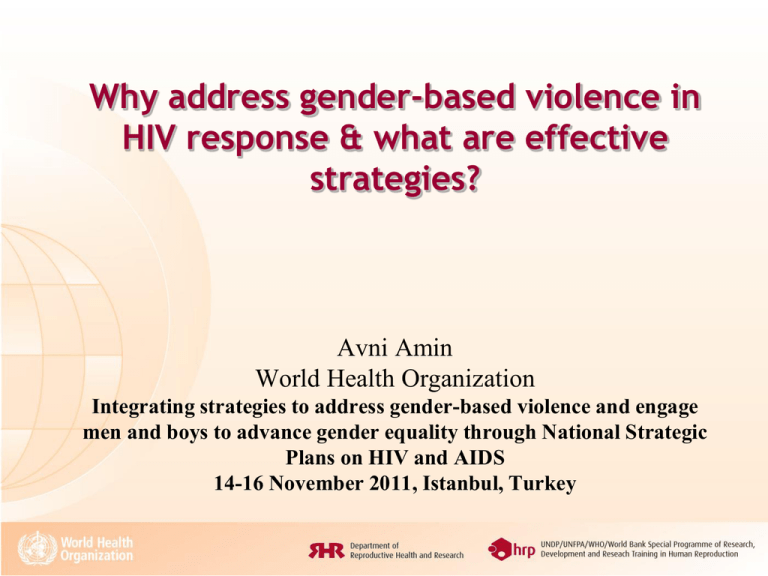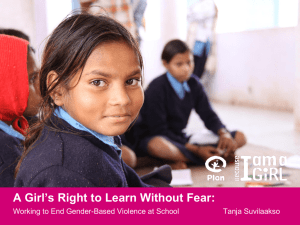
Why address gender-based violence in
HIV response & what are effective
strategies?
Avni Amin
World Health Organization
Integrating strategies to address gender-based violence and engage
men and boys to advance gender equality through National Strategic
Plans on HIV and AIDS
14-16 November 2011, Istanbul, Turkey
Part 1: Why address gender-based
violence in the HIV response?
Review data:
How widespread is gender-based violence?
How is gender-based violence linked to HIV ?
Definition: gender-based violence (GBV)
GBV: violence involving men & women; derived from unequal
power relationships between men and women; includes physical,
sexual & psychological harm:
acts of physical aggression
emotional, psychological abuse & controlling behaviours
coerced sex, sexual harassment, rape
Violence against women (VAW): public or private act of genderbased violence that results, or likely to result in physical, sexual or
psychological harm to women.
Different forms of GBV
Sexual, physical, or emotional violence by an intimate partner
(intimate partner violence or IPV) & non partners;
Child sexual abuse
Sexual violence in conflict situations
Sexual harassment & abuse by authority figures (e.g teachers,
police officers or employers etc),
Forced prostitution and sexual trafficking
Child marriage
Violence perpetrated or condoned by the state.
Homophobic violence
Violence against women and men living with HIV
Key Message 1
Gender-based violence is a widespread
public health & human rights problem
worldwide.
Source: Preventing HIV by preventing violence: the global prevalence of intimate partner violence against women and its links with HIV infection. Devries K et al
2010. Paper presented at the Vienna AIDS Conference. Forthcoming publication on the Global Burden of Disease.
Prevalence of IPV: select countries
prevalence of intimate partner violence lifetime/ever and last 12 months
Indonesia, 2006, Other
Guatemala, 2008/2009, CDC-RHS
Malawi, 2004, DHS
Uganda, 2006, DHS
Turkey, 2009, WHO
country, source, year
Thailand city, 2005, WHO
Thailand province, 2002, WHO
Tajikistan, 2005, Other
IPV physical &/or sexual life time
IPV physical &/or sexual last 12 months
Russia 1999, CDC-RHS
Moldova, 2005, DHS
Nigeria, 2008, DHS
Egypt, 2005, DHS
Ecquador, 2004, CDC-RHS
China, 1999/2000, Other
Brazil province, 2001, WHO
Brazil city, 2001, WHO
0
10
20
30
40
50
60
70
percentage of women who experienced violence
Source: UN women , March 2011, Violence against women Prevalence Data: Surveys by country
Violence against vulnerable groups
Prevalence of recent rape by clients among female sex workers (FSW)
32% in Mombasa, Kenya (2007)
31% in Karnataka, India (2005)
26% in Macau, China (2011)
In Vancouver, Canada IDU survey
68% of women & 19% of men lifetime history of sexual violence
Child sexual abuse 33% for women, and 13% for men
In the USA in 2 studies:
68% young MSM : threats or violence from either family or
partners
25% threats or violence by both family & partners
Sources: Shannon K et al. A systematic review of gender-based violence and links to HIV infection among sex workers. Forthcoming 2012; Braistein P et al
2003); Spratt, Kai. 2010. Technical Brief: Integrating Gender into Programs with Most-at-Risk Populations. Arlington, VA: USAID's AIDS Support and Technical
Assistance Resources, AIDSTAR-One, Task Order 1.
Key Message 2
Gender-based violence is rooted in or a
manifestation of gender inequality in society:
Traditional gender norms perpetuate violence
against women .
Women’s agreement that wife-beating
justified for at least 1 reason
Source: Preliminary results, PAHO/CDC (forthcoming) “Violence against women in 12 countries from LAC”
Key Message 3
Gender-based violence is both a risk
factor for, and a potential consequence
of being identified as having HIV
Gender-based violence & HIV
Across all settings women who
have experienced IPV are 2X more
likely to be at risk of HIV/STI
infection compared to those with no
IPV
Source: Preventing HIV by preventing violence: the global prevalence of intimate
partner violence against women and its links with HIV infection. Devries K et al 2010.
Paper presented at the Vienna AIDS Conference. Forthcoming publication on the
Global Burden of Disease.
Gender-based violence & HIV
Longitudinal study, South Africa: HIV incidence in women with
multiple episodes of intimate partner violence 9.6 per 100 personyears vs 5.2 per 100 person-years among those with one or none (aIRR
=1.51); 12% of new HIV infections attributed to intimate partner
violence.
Tanzania: women seeking HIV counseling and testing who had
experienced violence were 2X more likely to be HIV positive
India, a study of 28,000 married women: those who experienced
physical & sexual violence from intimate partners over 3 X more likely
to be HIV-positive than those who had experienced no violence
Studies from India, South Africa & the USA: men who perpetrate
violence more likely to engage in high-risk sexual behaviours
Sources: Jewkes et al 2010. Lancet, Maman et al, 2002; Silverman et al, 2008; Raj et al 2006, Dunkle et al 2007, Jewkes et al 2006, Silverman et al 2007
Gender-based violence & HIV
Female Sex Workers, Thailand who experienced physical &/or
sexual violence 31% more likely to report an STI symptom (2010)
Sex workers, China:
who experienced client violence - 32% more likely to report
condom use failure compared to those who did not (2011).
who experienced high compared to low levels of client
violence (2008) - 2X as likely to report condom use failure.
Source: Shannon K et al. Forthcoming 2012;
Pathways linking GBV & HIV
Source: Jewkes et al. 2010
Part 2: Key strategies to address GBV
in the context of HIV/AIDS
programming?
Objectives part 2:
Identify:
Key principles & framework
Evidence-based interventions & strategies
Key Principles: Core values
A human rights approach
Promote gender equality
Non-discrimination
Meaningful participation
Safety first & confidentiality
Key Principles: Sound programming
Understand epidemiology of both HIV &GBV & links
Strategies that foster participatory learning
Use multiple entry points & approaches
Recognize needs of the most marginalized
Build competencies in understanding & responding to
GBV
Partnerships with range of stakeholders
Rigorous monitoring & evaluation
Ecological framework for programming
Socioeconomic
conditions
Laws &
Policies
Individual Behaviour
Choice in partner(s)
Choice to have sex
Partner reduction
Condom use
Drug use or non use
Couples & families
Communities
Countries
Cultural &
Social Gender
Norms
Address gender inequality as driver of GBV & HIV
Empowering women:
Microfinance, education,
relationship skills,
community mobilization
IMAGE, Stepping Stones,
Sex workers: Sonagachi
Laws &
Policies
Promoting GE laws&
policies:
Equal inheritance laws
Laws against violence
Training law enforcement
National standards on postrape care
Socioeconomic
conditions
Individual Behaviour
Choice in partner(s)
Choice to have sex
Partner reduction
Condom use
Drug use or non use
Couples & families
Communities
Countries
Transforming harmful
gender norms
Soul City,
Sexto Sentido
Stepping Stones
Cultural &
Social Gender
Norms
Engaging men and boys
Changing male norms &
behaviours
Program H, Yaari Dosti,
One Man Can, Men As
Partners
Address GBV in HIV prevention, treatment & care
Prevention:
Behaviour Change Communication integrate: Violence & HIV risk messages
Individual, Group, Peer Counselling: Combined risk-reduction & violence prevention:
self-esteem, negotiation skills, partner communication, trauma counselling,
HIV Testing & Counselling:
Training HIV counsellors in identifying & appropriate response to GBV
Safety planning, disclosure support
PMTCT
Treatment
Care &
Support
Couple Counselling
& Testing
Involving
male partners
Comprehensive
Post-rape care
including PEP
Peer
& mediated
disclosure
support
Key
populations
Sex Workers
Substance abusers
(IDU, drug &
alcohol)
MSM
Survivors of GBV
Women with
prison history
partners of
substance abusers
Adolescents
WHO Resources on GBV & HIV
Links:
www.who.int/gender
www.who.int/reproductivehe
alth/publications/violence/en/
Email Avni Amin
amina@who.int









